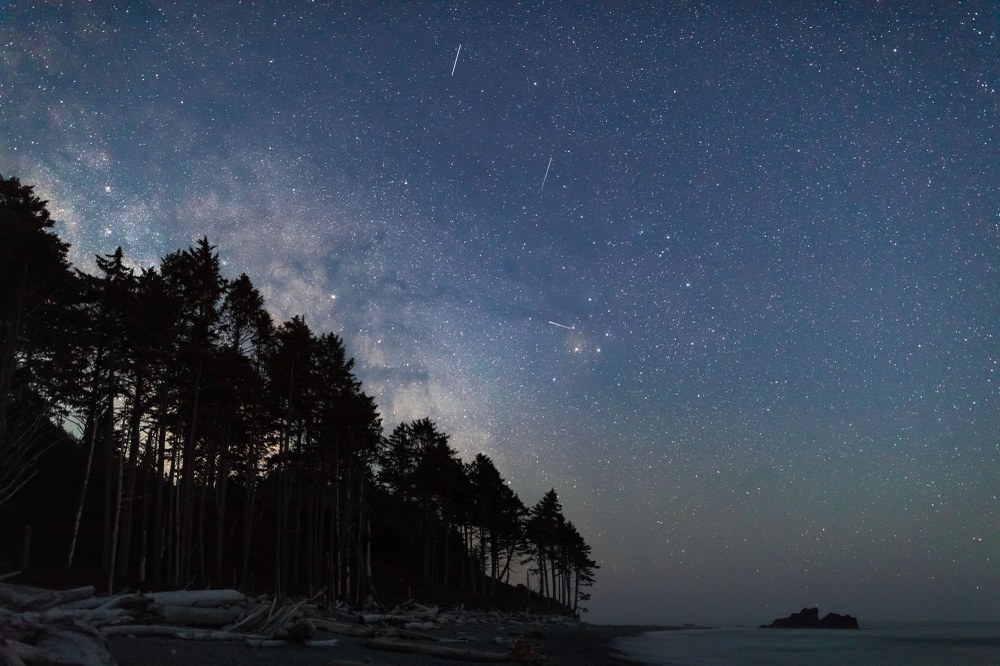
After a long, hot day on the trail, you’ve finally settled in at camp. With the tent pitched and your Mountain House Creamy Mac n’ Cheese devoured, the temptation to sleep can be overwhelming. Every bone in your body is telling you to climb into your tent and get horizontal. But you have to fight it: if you hold off long enough, you may get lucky and witness a remarkable natural spectacle in the summer sky.
The Perseids
The annual Perseid meteor showers will be arriving soon, sending streaks of light through the night skies and awing spectators across the Northern Hemisphere. These showers are called the Perseids because the point from which they appear to hail (the radiant) lies in the constellation Perseus. This name aids viewers in determining which shower they are watching on a given night, but Perseus is not the true source of the meteors.
With very bright and fast meteors, this astronomical event is considered one of the best meteor showers of the year, and here in the Pacific Northwest we are in a prime location to enjoy the Perseids’ fiery displays. The annual phenomenon begins in mid-July and reaches its peak at the height of summer (this year it will be August 11-12). At its height, stargazers can often spot up to 100 meteors per hour. Netflix can’t compare.
Meteoroid, meteor, or meteorite?
Curious what to call those flashes of light? The short answer is, it depends on their location.
Meteoroid is the scientific term for a space rock. Meteoroids are pieces of other, larger objects that have shattered – sometimes millions of years ago – and are still adrift in space. Some have broken off from comets, others from asteroids, and some even come from the moon or other planets.
When meteoroids enter Earth’s atmosphere, they are now known as meteors. Traveling at tens of thousands of miles per hour, most meteoroids burn up and disintegrate when they hit the mesosphere, resulting in a bright flare tracing their path. These fiery streaks are what many sky-watchers refer to as shooting or falling stars. When a large grouping of meteoroids enter our atmosphere, we are treated to a meteor shower. If a meteoroid survives this extended trip through the atmosphere and lands on the ground, the solid piece of debris is called a meteorite.
The Swift-Tuttle comet
As comets move around the sun, they leave a dusty trail of meteoroids behind them. Every year Earth passes through these debris trails, causing meteoroids to collide with our atmosphere and, as they burn up, paint wide arcs of light across the sky. The bits of space debris interact with our atmosphere to produce the Perseids originate from the big and slow Swift-Tuttle comet. This comet takes close to 135 years to orbit the sun once, and its nucleus is 16 miles across - that’s almost twice the size of the object that caused dinosaurs to go extinct!
Viewing tips
Observing a meteor shower depends on an equal measure of good planning and luck. Light pollution, weather, and smoke are factors to consider when choosing a destination. For the brightest display, go to a spot far away from the city so that light pollution doesn’t muddle the scene. The best viewing times are between 2am and dawn, as this is when the sky will be darkest and when our side of the earth will be moving into the cloud of debris.
Watching the Perseid showers might mean an all-nighter, but this chance to admire meteors dancing in the sky is well worth the groggy, contented morning hike back to the trailhead.
This article originally appeared in our Summer 2022 issue of Mountaineer Magazine. To view the original article in magazine form and read more stories from our publication, visit our magazine archive.
 Issy Steckel
Issy Steckel